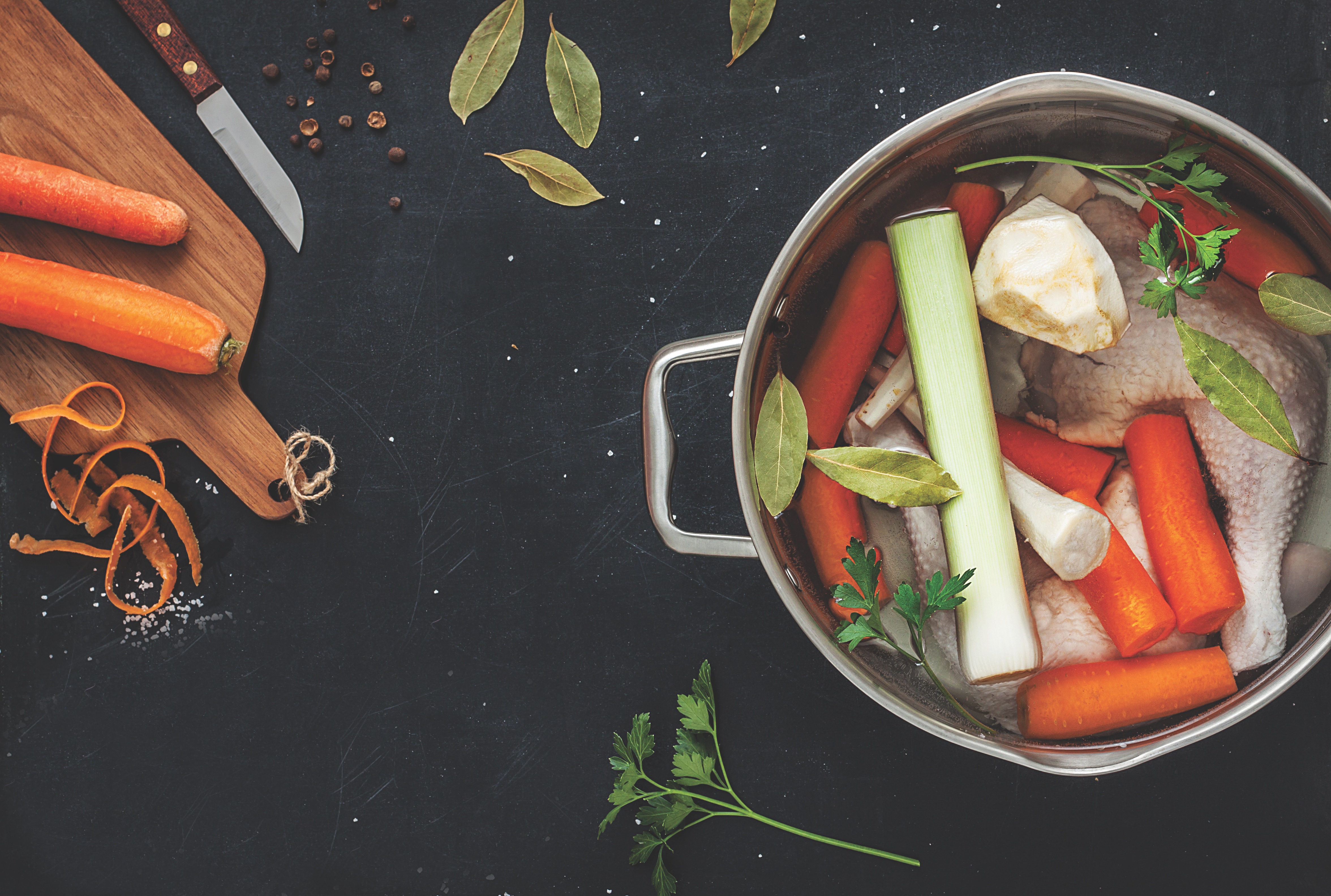
Soup is the culinary equivalent of love. I know that’s a pretty bold statement, but I fiercely stand behind it.
I once read that Chinese families used to keep a pot of soup on the stove — for generations. They would top it off all day with vegetable and meat scraps, bones and herbs, and keep it on the stove simmering away ad infinitum. This means that every time they ate soup, they ate a part of their ancestry. Imagine always having your grandmother’s and great-grandmother’s soup DNA in there nourishing you.
As a half-Ashkenazi Jew, the concept of a perpetual pot of soup on the stove is very appealing. After all, have you ever met an Ashkenazi who didn’t begin his or her meal with soup? This hardy stock of folks historically has been raised on hardy stock — literally. In the frigid winters of Eastern Europe, a nourishing and comforting bowl of soup was the difference between life and death.
One day, on a trip to visit family in Israel, I was invited to lunch by one of my mother’s Romanian cousins. I walked into the house and was almost struck speechless by an incredible smell. A nearly visceral image of my grandmother came to mind, and I rushed into the kitchen to see what was cooking.
“Leustean,” my cousin Beatrice said, laughing. “I put it in the chicken soup. Your grandmother used it — all Romanians do.”
And there it was, that special smell and flavor I had been chasing for my entire life summed up in a word I’d never heard.
“Leustean?” I asked, sticking a spoon in the pot to taste.
“Leustean is Romanian for lovage,” my smarty pants uncle chimed in.
I called my mother to tell her that I had finally found a clue to safta’s soup. We ordered a pound of dry lovage and added it to our chicken soup. Suddenly, my mother’s face lit up.
“Leustean,” she said. “I’ve been chasing this taste for years.”
Since the day my grandmother reached down through the great divide to remind me about lovage, I’ve never made chicken soup without it. Lovage, an herb from the dill family, is what is used to flavor bouillon cubes. Surprisingly, even though it’s one of the most ubiquitous taste profiles, most of us don’t have a name for it, and I’ve yet to find a customer who can identify it.
So now that you know the secret to great chicken soup, here is my “recipe” for chicken stock. This is the quintessential Jewish mother’s remedy to everything that ails you — from a cold to heartbreak.
If there is one thing you learn to do in the kitchen, learn to make stock. It will fill your home with the aroma of your ancestors, it’s a bowl of vitamins in disguise, and it will earn you a lifetime of accolades from admirers who can’t quite figure out why your chicken soup tastes so special. And if you have kids, this just doubles the incentive because there is never a time when I make chicken soup that I don’t hold my mother and my grandmother in my heart and mind the entire time.
If that’s not love in a bowl, I don’t know what is.
WORLD’S BEST CHICKEN SOUP STOCK
Bones of at least 3 chickens or 1 whole chicken
1 head garlic, unpeeled
3 carrots, washed, peeled and cut into chunks
8 ribs of celery, washed and roughly chopped
2 parsnips, washed, peeled and cut into chunks
1 sweet potato, peeled and chopped
1 whole celery root
2 large yellow onions, unpeeled, washed
and cut into quarters
1 small green pepper, washed, deseeded
and cut into quarters
Handful parsley stems
Handful cilantro stems
Handful dill stems
Handful lovage stems (or 2 tablespoons
dry lovage)
6 whole black peppercorns
1 inch fresh ginger
1/2 teaspoon turmeric powder
1 hot green pepper left whole (optional)
BEFORE SERVING
Salt to taste
Black pepper to taste
Sugar to taste
1 tablespoon finely chopped leaves of parsley
and dill, for garnish
Put all ingredients into a large pot. Cover all with cold water and turn the heat to high. Skim the scum that rises to the top of the pot as it heats and discard.
At the first boil, lower the heat to a slow simmer and partially cover pot for a minimum of 2 hours — 4 is better. If you used a whole chicken, feel free to remove the meat after a few hours and leave the bones in the pot to continue simmering; that’s where the flavor comes from, anyway.
And there it was, that special smell and flavor I had been chasing for my entire life summed up in a word I’d never heard.
When your stock is done, turn off the heat and let the liquid cool until you can handle it. Take a large sieve and put it over another pot and strain out all the solids. At this point, you should have a dark, yellow, fragrant stock and a heap of mushy vegetables and bones in the strainer. If you didn’t remove your chicken and you enjoy stringy boiled chicken — I sometimes do — then pull the chicken out and keep it in the refrigerator to add back into the stock later. If not, feed this resulting mush to your pets; they will enjoy it much more than you will. (Warning: Dogs should not eat onions or garlic, and never give a dog poultry bones.)
Strain the stock one more time. (The French strain 7 times, but I don’t. The clearer you want your stock, the more you strain.)
Leave your stock in the fridge to jell overnight. The stock will separate and the fat will rise to the top in a hard yellow layer. This is the gelatin and collagen from the bones and marrow of the chicken, and it’s great for your hair, nails and skin, and part of the reason that chicken soup is a wonder drug for the flu. Keep this golden schmaltz and use it to cook rice or vegetables or to fry latkes or sweet potato fritters.
You can put some stock in the freezer in jars or continue on and make any type of soup you fancy: lentil, split pea, black bean or tomato. Do you want to make chicken soup? Add back some chopped raw carrots, chicken breast and some snips of fresh herbs — and maybe even some matzo balls or noodles. Important to note, this is unseasoned stock.
When you are ready to serve, be sure to season your stock with salt, black pepper and a touch of sugar to taste.
Yamit Behar Wood, an Israeli-American food and travel writer, is the executive chef at the U.S. Embassy in Kampala, Uganda, and founder of the New York Kitchen Catering Co.























 More news and opinions than at a Shabbat dinner, right in your inbox.
More news and opinions than at a Shabbat dinner, right in your inbox.